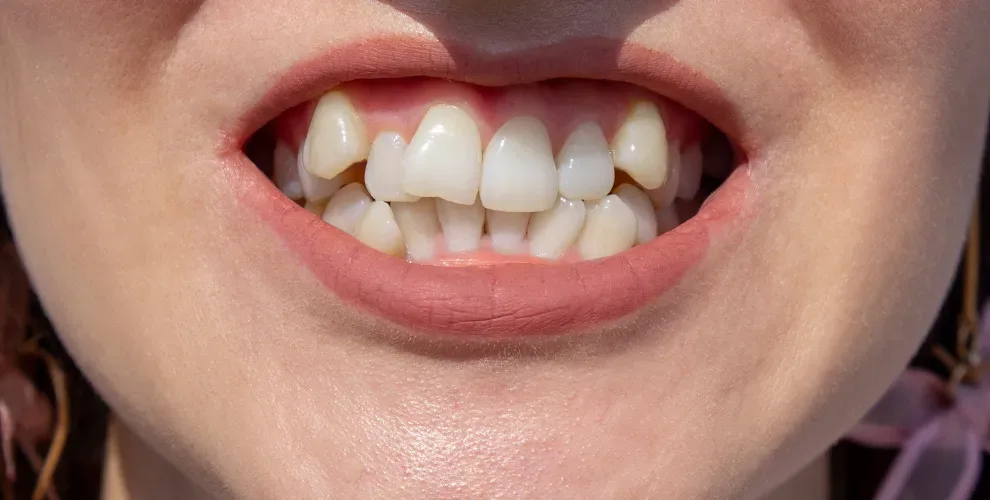How to Fix a ‘Snaggle Tooth’: Options, Costs & More.

Table of Contents
- What is a Snaggle Tooth?
- Complication of an Untreated Tooth
- Treatment Options & Costs
- Long-Term Options
- How to Clean Your Mouth
A tooth that is twisted, or pushed forward or behind the rest of your teeth, is sometimes referred to as a snaggletooth. A tooth like this may be hard to keep clean, so it can lead to enhanced tooth decay (and potential tooth loss). A snaggletooth can also impair your confidence, especially when you smile.
You have a lot of options to fix a snaggletooth, including braces, aligners, veneers, or tooth contouring.
What is a Snaggle Tooth?
A snaggle tooth is an irregular, odd-shaped, or projecting tooth that looks out of line compared to your other teeth.
This is simply a tooth that is misaligned with the others in your mouth. Perhaps it is turned at an angle while the others are not, or it may be pushed forward or behind your other teeth. A snaggle tooth may also be broken, giving it a pointy appearance.
Having a snaggle tooth may impact the way you feel about your smile. You may feel embarrassed about your appearance or self-conscious about how your mouth appears in photographs or in online meetings. Some countries prize a snaggle tooth as fashionable or beautiful, but in the United States, it is not considered part of an ideal appearance.
The presence of a snaggle tooth indicates that your teeth are crowded together. It may be a relatively easy situation to fix.
A snaggle tooth is a broken or crooked tooth that looks out of line compared to your other teeth and this can impact your confidence, but a snaggle tooth is relatively easy to fix.
Complications of an Untreated Snaggle Tooth
A snaggle tooth may impact more than just your self-confidence. Untreated, a snaggle tooth can also lead to the following issues:
Tooth decay and gum disease: A snaggle tooth can indicate your mouth has overcrowding. This means there may be hard-to-reach areas between teeth that are difficult to clean. Plaque and food particles may accumulate in these pockets and result in a buildup of bacteria that could lead to gum problems and decay.If your snaggle tooth is pointy or comes in contact with another area of your gum or inner mouth, this could also cause gum irritation and further inflammation.
Bad breath: Bacteria that gather in the pockets around your snaggle tooth, or in the areas between crowded teeth that are too hard to clean, may cause chronic bad breath.
Bite issues: Misaligned teeth can create unnatural wear patterns, stress on the teeth, and eventually damage like fractures or cracks.
Jaw problems: Crowded or misaligned teeth can put stress on the jaw and even cause headaches, neck and shoulder pain, and teeth clenching or TMJ disorders.
Any or all of these dental problems can be very expensive to fix, and they can cause discomfort that’s hard to fix. If you have a snaggletooth, it’s best to talk with your dentist about your available treatment options.
Ways to Fix a Snaggle Tooth and their Costs
Pediatric dentists monitor children’s teeth and will recommend braces, usually during the teenage years, to straighten the teeth. Even if you had braces as a teen, you may have alignment issues as an adult.
Your teeth continue to move throughout life because of genetics, wisdom tooth crowding, oral health, and various habits like smoking. It is normal for most people’s teeth to move, and increasingly, adults are turning to various options to improve the alignment of their teeth.
Here are some of the most popular options to fix a snaggletooth or other crowding or alignment problems. This chart can help you examine them at a glance:
Snaggletooth Treatment | Cost | Eligible for Dental Insurance? | Duration of Treatment | Who Is It For? |
Traditional braces | $4,000–$7,000 | Yes | 12–14 months | People with multiple misaligned teeth, moderate-to-severe cases |
Ceramic (Invisible) braces | $4,000–$8,000 | Yes | 12–14 months | People with multiple misaligned teeth, moderate-to-severe cases, people willing to pay more for aesthetics |
Lingual braces | $6,000–$13,000 | No | 18–30 months | People who need discreet treatment, mild-to-moderate snaggletooth |
At-home aligners | $900–$2,500 | Maybe | 6–18 months | Mild snaggletooth, people who are disciplined and willing to follow the plan |
In-office aligners | $3,000–$8,000 | Maybe | 12–24 months | Mild to moderate snaggletooth, need more dental supervision |
Veneers | $2,000–$24,000 for a 4–6 tooth procedure | No | 1–2 appointments | Minor snaggletooth, people who are focused on aesthetics and not underlying problems |
Tooth contouring | $50–$500 per tooth | No | Single appointment | Very minor misalignment or chipping |
How to Clean Your Mouth With a Snaggletooth
A snaggletooth can make cleaning your teeth difficult, but it’s important to do your best to remove food and plaque. These tips can help:
Brush Like a Pro
Pick a soft-bristled toothbrush and place it at a 45-degree angle to your gums. Use very small, gentle circles to clean your snaggletooth and the teeth around it.
Floss Regularly
It may be hard to slide traditional floss around a snaggletooth, but products like floss threaders and water flossers can help you remove debris between your teeth. No matter which method you choose, remember to floss at least once per day and address both your snaggletooth and its neighbors.
Swish a Mouthwash
An antiseptic mouthwash can kill bacteria caused by a snaggletooth and freshen breath. Use a product you like after brushing and flossing, and remember to spit out the excess instead of swallowing it. Read the product instructions carefully, as some ask you to avoid eating and drinking for a few minutes.
Best Long-Term Options for Fixing a Snaggle Tooth
The optimal method to correct your snaggle tooth depends on its severity as well as how the rest of your teeth are aligned. If you have a severe case of misalignment, including extensive bite issues, braces may be your best bet.
Doctor-monitored, at-home aligners are often the most effective and affordable option to correct minor to moderate issues, including a mild snaggle tooth. These plastic, customized teeth aligners are inexpensive. You can often pay in installments, and the treatment plan takes much less time than braces.
Aligners are significantly less invasive than surgeries or cosmetic procedures like veneers or tooth contouring.
